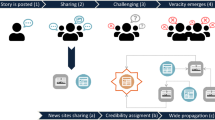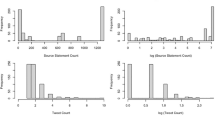Abstract
This paper considers the relation between a rumor maker and many disseminators as a game and sets up Explosion-Trust (ET) Game Model. This model regards rumor explosion degree and trust degree of source node as influential factors of rumor making and spreading. The purpose of on both sides of a game is to obtain a maximum benefit. Based on ET model, we make experiments imitating the mode of information dissemination in social networks. We find rumor makers don’t make rumors with quite a high explosion degree because others will doubt the truth of such rumor bringing a low transmission rate. This paper finds an optimal value for rumor spreading by experiments and on what condition trust degree will have an important impact on rumor spreading. Based on experiment results, the authors sum up the universal characteristics of rumors spread widely. Conclusions will be used to detect rumors.





Similar content being viewed by others
References
Peterson WA, Gist NP (1951) Rumor and public opinion. Am J Sociol 57(2):160–163
Jiang S (2012) Formation, transmission and public opinion guiding mechanism of network rumors. Chongqing Soc Sci 6:19–20
Fengming Liu L, Wang H, Johnson H, Zhao (2015) Analysis of network trust dynamics based on evolutionary game, Scientia Iranica. Trans E. Indus Eng 22(6):2548–2557
Huo L (2012) False information spreading research after emergencies. Shanghai Jiaotong University, Shanghai
Huo L, Huang P, Guo CX (2012) Analyzing the dynamics of a rumor transmission model with incubation. Discr Dyn Nat Soc 2012:21 (Article ID 328151)
Moreno Y, Nekovee M, Pacheco AF (2004) Dynamics of rumor spreading in complex networks. Phys Rev E 69(6):066130
Han S, Zhuang FZ, He Q, Shi Z, Ao X (2014) Energy model for rumor propagation on social networks. Physica A Stat Mech Appl 394(2):99–109
Naimi Y, Naimi M (2013) Reliability and efficiency of generalized rumor spreading model on complex social networks. Commun Theor Phys 07:139–144
Giakkoupis G, Wowlfel P (2011) On the randomness requirements of rumor spreading. Proceedings of the 22nd annual ACM-SIAM symposium on discrete algorithms. Society for Industrial and Applied Mathematics, Philadelphia, pp 449–461
Berenbrink P, Elsässer R, Sauerwald T (2010) Communication complexity of quasirandom rumor spreading. Algorithms—ESA 2010, Berlin, Germany, pp 134–145
Sauerwald T, Stauery A et al (2011) Rumor spreading and vertex expansion on regular graphs. Proceedings of the 22nd ACM-SIAM Symposium. Francisco, Calif, USA, pp 462–475
Isham V, Harden S, Nekovee M (2010) Stochastic epidemics and rumors on finite random networks. Phys A 389(3):561–576
Benjamin D, Mahmoud F, Tobias F (2012) Experimental analysis of rumor spreading in social networks. Design and analysis of algorithms, vol 7659 of Lecture Notes in Computer Science, Berlin, Germsny, pp 159–173
Zhao LJ, Cui HX, Qiu XY, Wang X, Wang J (2013) SIR rumor spreading model in the new media age. Phys A 392(4):995–1003
Zhao L, Wang J, Huang R (2014) SIRaRu rumor spreading model in complex networks. Phys A 398:43–55
Gu J, Li W, Cai X (2008) The effect of the forget-remember mechanism on spreading. Eur Phys J B 62(2):247–255
Zhao L, Xie W, Oliver Gao H, Qiu X, Wang X, Zhang S (2013) A rumor spreading model with variable forgetting rate. Physica A: Stat Mech Appl 392:6146–6154
Zhao LJ, Qiu XY, Wang XL, Wang J (2013) Rumor spreading model considering forgetting and remembering mechanisms in inhomogeneous networks. Phys A 392(4):987–994
Zhang Y, Xu J, Vecchio A (2015). A rumor spreading model considering the cumulative effects of memory. Discr Dyn Nat Soc 2015:11
Zhao XX, Wang JZ, Yuan S (2014) Dynamical behaviors of rumor spreading model with control measure. Abstr Appl Anal 2014:11
Zhu X, Liu F (2017) Research on behavior model of rumor maker based on system dynamics. Complexity 2017:9. https://doi.org/10.1155/2017/5094218 (Article ID 5094218)
Author information
Authors and Affiliations
Corresponding author
Additional information
Publisher’s Note
Springer Nature remains neutral with regard to jurisdictional claims in published maps and institutional affiliations.
Rights and permissions
About this article
Cite this article
Liu, F., Li, M. A game theory-based network rumor spreading model: based on game experiments. Int. J. Mach. Learn. & Cyber. 10, 1449–1457 (2019). https://doi.org/10.1007/s13042-018-0826-5
Received:
Accepted:
Published:
Issue Date:
DOI: https://doi.org/10.1007/s13042-018-0826-5




